Leadership: Exploring Theories, Practices, and Personal Growth
VerifiedAdded on 2020/05/28
|10
|2475
|63
Report
AI Summary
This report provides a comprehensive overview of leadership, exploring various theories, practices, and the importance of personal development. It begins by defining leadership and its significance, emphasizing motivation, guidance, and team building. The report delves into specific leadership principles, including the Pareto principle and Stephen Covey's seven habits of effective people. It highlights the importance of empathy, communication, and the 'begin with the end in mind' approach. The report also analyzes the strengths and weaknesses of empathic leadership, discusses qualities of a good chairperson, and examines Belbin team roles. Furthermore, it critiques practice-based change models, such as Kotter's leading change and the Kaizen model, and concludes with a personal development plan. The report is rich with references to support the analysis.

Running Header: Leadership
Leadership
Authors ID:
Authors Name:
Leadership
Authors ID:
Authors Name:
Paraphrase This Document
Need a fresh take? Get an instant paraphrase of this document with our AI Paraphraser
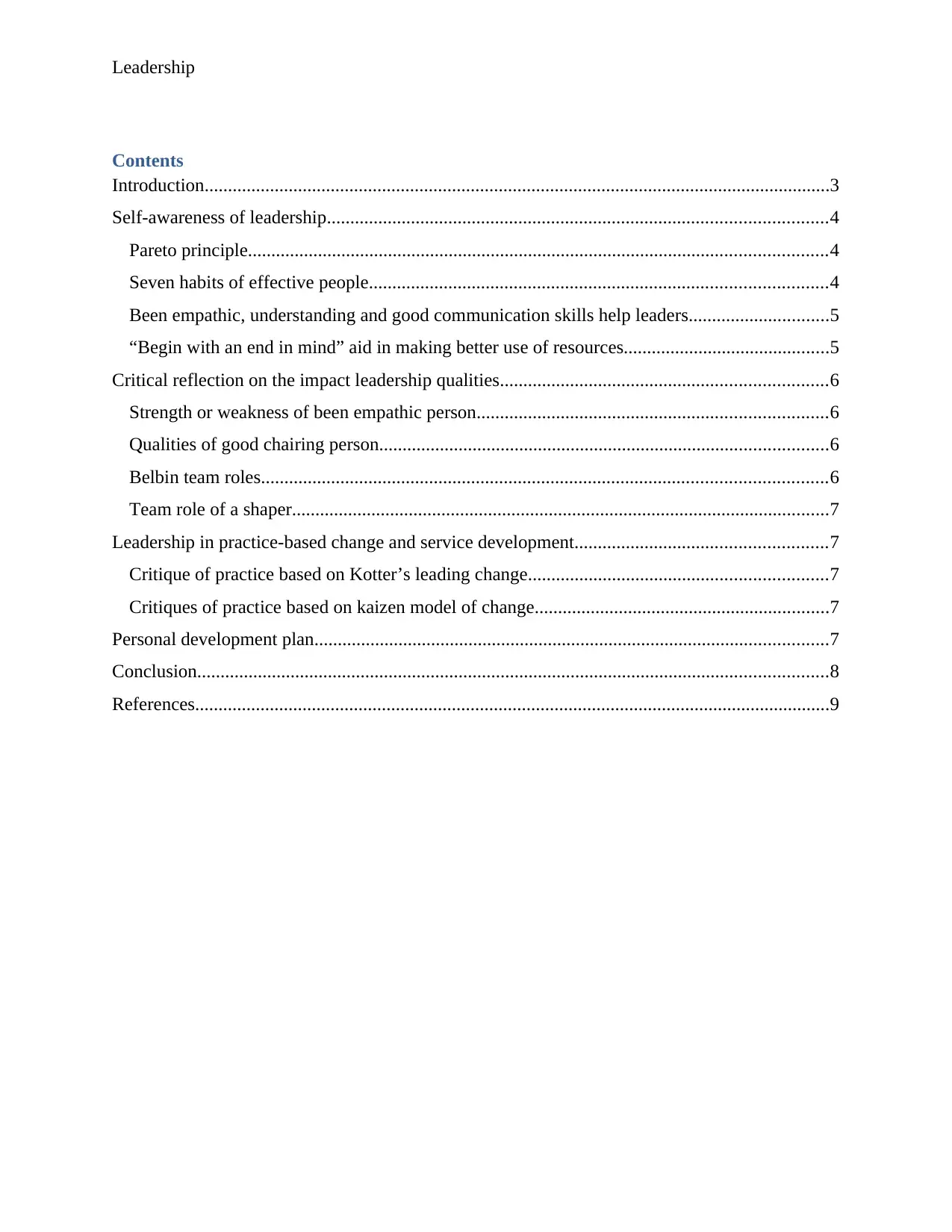
Leadership
Contents
Introduction......................................................................................................................................3
Self-awareness of leadership...........................................................................................................4
Pareto principle............................................................................................................................4
Seven habits of effective people..................................................................................................4
Been empathic, understanding and good communication skills help leaders..............................5
“Begin with an end in mind” aid in making better use of resources............................................5
Critical reflection on the impact leadership qualities......................................................................6
Strength or weakness of been empathic person...........................................................................6
Qualities of good chairing person................................................................................................6
Belbin team roles.........................................................................................................................6
Team role of a shaper...................................................................................................................7
Leadership in practice-based change and service development......................................................7
Critique of practice based on Kotter’s leading change................................................................7
Critiques of practice based on kaizen model of change...............................................................7
Personal development plan..............................................................................................................7
Conclusion.......................................................................................................................................8
References........................................................................................................................................9
Contents
Introduction......................................................................................................................................3
Self-awareness of leadership...........................................................................................................4
Pareto principle............................................................................................................................4
Seven habits of effective people..................................................................................................4
Been empathic, understanding and good communication skills help leaders..............................5
“Begin with an end in mind” aid in making better use of resources............................................5
Critical reflection on the impact leadership qualities......................................................................6
Strength or weakness of been empathic person...........................................................................6
Qualities of good chairing person................................................................................................6
Belbin team roles.........................................................................................................................6
Team role of a shaper...................................................................................................................7
Leadership in practice-based change and service development......................................................7
Critique of practice based on Kotter’s leading change................................................................7
Critiques of practice based on kaizen model of change...............................................................7
Personal development plan..............................................................................................................7
Conclusion.......................................................................................................................................8
References........................................................................................................................................9
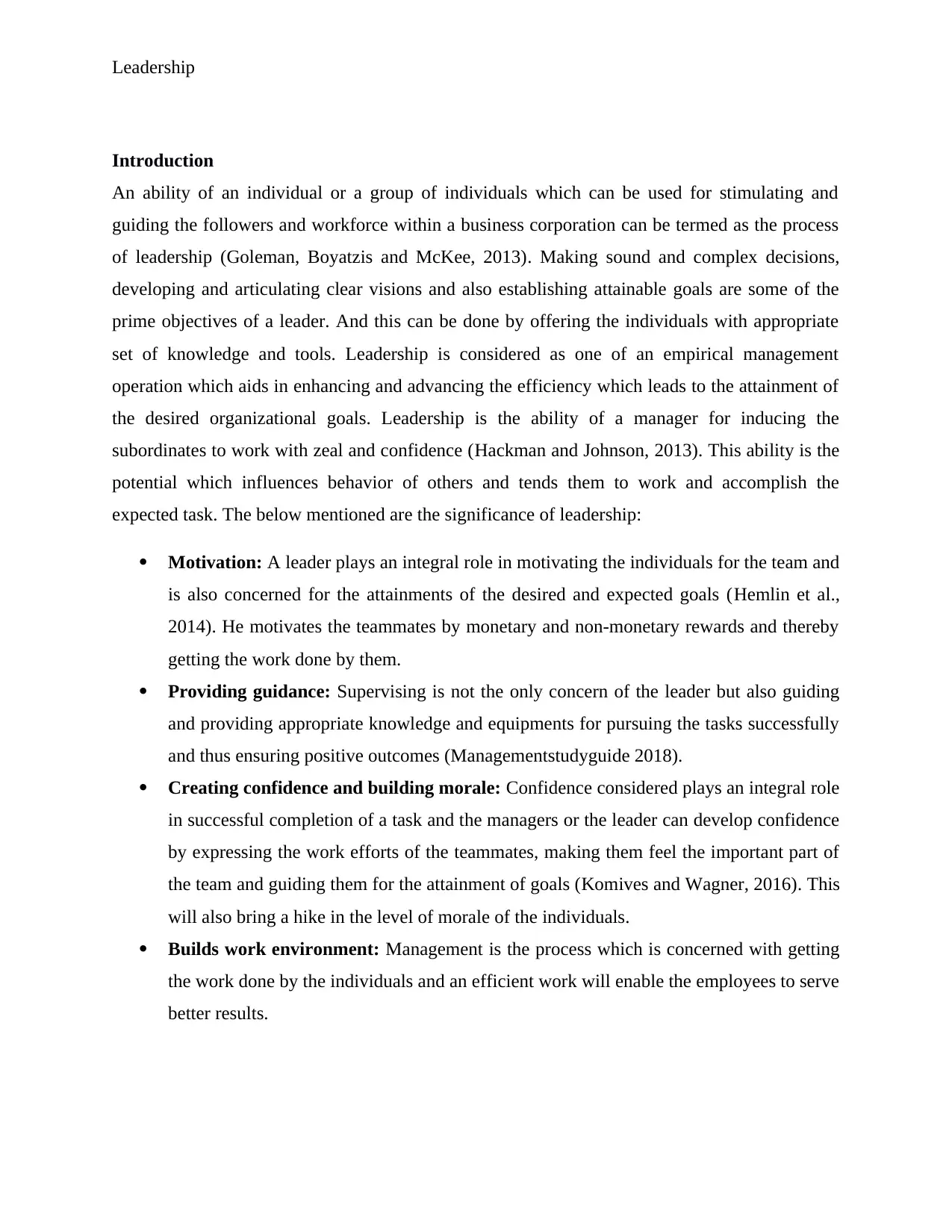
Leadership
Introduction
An ability of an individual or a group of individuals which can be used for stimulating and
guiding the followers and workforce within a business corporation can be termed as the process
of leadership (Goleman, Boyatzis and McKee, 2013). Making sound and complex decisions,
developing and articulating clear visions and also establishing attainable goals are some of the
prime objectives of a leader. And this can be done by offering the individuals with appropriate
set of knowledge and tools. Leadership is considered as one of an empirical management
operation which aids in enhancing and advancing the efficiency which leads to the attainment of
the desired organizational goals. Leadership is the ability of a manager for inducing the
subordinates to work with zeal and confidence (Hackman and Johnson, 2013). This ability is the
potential which influences behavior of others and tends them to work and accomplish the
expected task. The below mentioned are the significance of leadership:
Motivation: A leader plays an integral role in motivating the individuals for the team and
is also concerned for the attainments of the desired and expected goals (Hemlin et al.,
2014). He motivates the teammates by monetary and non-monetary rewards and thereby
getting the work done by them.
Providing guidance: Supervising is not the only concern of the leader but also guiding
and providing appropriate knowledge and equipments for pursuing the tasks successfully
and thus ensuring positive outcomes (Managementstudyguide 2018).
Creating confidence and building morale: Confidence considered plays an integral role
in successful completion of a task and the managers or the leader can develop confidence
by expressing the work efforts of the teammates, making them feel the important part of
the team and guiding them for the attainment of goals (Komives and Wagner, 2016). This
will also bring a hike in the level of morale of the individuals.
Builds work environment: Management is the process which is concerned with getting
the work done by the individuals and an efficient work will enable the employees to serve
better results.
Introduction
An ability of an individual or a group of individuals which can be used for stimulating and
guiding the followers and workforce within a business corporation can be termed as the process
of leadership (Goleman, Boyatzis and McKee, 2013). Making sound and complex decisions,
developing and articulating clear visions and also establishing attainable goals are some of the
prime objectives of a leader. And this can be done by offering the individuals with appropriate
set of knowledge and tools. Leadership is considered as one of an empirical management
operation which aids in enhancing and advancing the efficiency which leads to the attainment of
the desired organizational goals. Leadership is the ability of a manager for inducing the
subordinates to work with zeal and confidence (Hackman and Johnson, 2013). This ability is the
potential which influences behavior of others and tends them to work and accomplish the
expected task. The below mentioned are the significance of leadership:
Motivation: A leader plays an integral role in motivating the individuals for the team and
is also concerned for the attainments of the desired and expected goals (Hemlin et al.,
2014). He motivates the teammates by monetary and non-monetary rewards and thereby
getting the work done by them.
Providing guidance: Supervising is not the only concern of the leader but also guiding
and providing appropriate knowledge and equipments for pursuing the tasks successfully
and thus ensuring positive outcomes (Managementstudyguide 2018).
Creating confidence and building morale: Confidence considered plays an integral role
in successful completion of a task and the managers or the leader can develop confidence
by expressing the work efforts of the teammates, making them feel the important part of
the team and guiding them for the attainment of goals (Komives and Wagner, 2016). This
will also bring a hike in the level of morale of the individuals.
Builds work environment: Management is the process which is concerned with getting
the work done by the individuals and an efficient work will enable the employees to serve
better results.
⊘ This is a preview!⊘
Do you want full access?
Subscribe today to unlock all pages.

Trusted by 1+ million students worldwide

Leadership
Self-awareness of leadership
Pareto principle
On the basis of the observations made by French-Italian Economist and Sociologist Vilfredo
Pareto's, it is noted that the 80% of the wealth of the nineteenth century England by 20% of the
population had an overwhelmingly profound effect on present-day society. This rule can be
applied to the concept of leadership as it is all about focusing on that which is most important (
2015). Pareto’s principle can be considered as an effective tool for leading in a more better and
efficient manner and the same has been elaborated as follows:
a) Decision making:- According to this principle, the leader should gather 80% of the
required information or data and decisions should be taken in 20% of the time allotted
(Northouse, 2017). The decisions should be made quickly as time should not be wasted in
analyzing the collected data.
b) Ideation: The contribution of ideas should be more from the teammates. According to
Pareto's principle, the 80% contribution of ideas should be of teammates and 20% should
be the leader (Jackson and Parry, 2011). This will save the time of leader and will enable
them to invest in other operations such as problem-solving etc.
Seven habits of effective people
According to the theory of Stephen R Covey, it has been described that there are 7 habits which
are required to be possessed by a leader for pursuing effective leadership (Chhokar, Brodbeck
and House, 2013). The below mentioned are the 7 habits which are considered as the main
components of this theory:
Habit 1: Be proactive – The concept is all about taking responsibility for your life, proactive
people are “response-able” and they don’t blame genetics, circumstances, conditions, or
conditioning for their behavior. Whereas reactive people are often affected by their physical
environment and they blame external sources.
Habit 2: Begin with the end in the mind – This habit is based on imagination. It is based on the
principle that all the things are created twice (Selznick, 2011). In this habit mental creation is
considered at first place and physical creation at second place.
Self-awareness of leadership
Pareto principle
On the basis of the observations made by French-Italian Economist and Sociologist Vilfredo
Pareto's, it is noted that the 80% of the wealth of the nineteenth century England by 20% of the
population had an overwhelmingly profound effect on present-day society. This rule can be
applied to the concept of leadership as it is all about focusing on that which is most important (
2015). Pareto’s principle can be considered as an effective tool for leading in a more better and
efficient manner and the same has been elaborated as follows:
a) Decision making:- According to this principle, the leader should gather 80% of the
required information or data and decisions should be taken in 20% of the time allotted
(Northouse, 2017). The decisions should be made quickly as time should not be wasted in
analyzing the collected data.
b) Ideation: The contribution of ideas should be more from the teammates. According to
Pareto's principle, the 80% contribution of ideas should be of teammates and 20% should
be the leader (Jackson and Parry, 2011). This will save the time of leader and will enable
them to invest in other operations such as problem-solving etc.
Seven habits of effective people
According to the theory of Stephen R Covey, it has been described that there are 7 habits which
are required to be possessed by a leader for pursuing effective leadership (Chhokar, Brodbeck
and House, 2013). The below mentioned are the 7 habits which are considered as the main
components of this theory:
Habit 1: Be proactive – The concept is all about taking responsibility for your life, proactive
people are “response-able” and they don’t blame genetics, circumstances, conditions, or
conditioning for their behavior. Whereas reactive people are often affected by their physical
environment and they blame external sources.
Habit 2: Begin with the end in the mind – This habit is based on imagination. It is based on the
principle that all the things are created twice (Selznick, 2011). In this habit mental creation is
considered at first place and physical creation at second place.
Paraphrase This Document
Need a fresh take? Get an instant paraphrase of this document with our AI Paraphraser
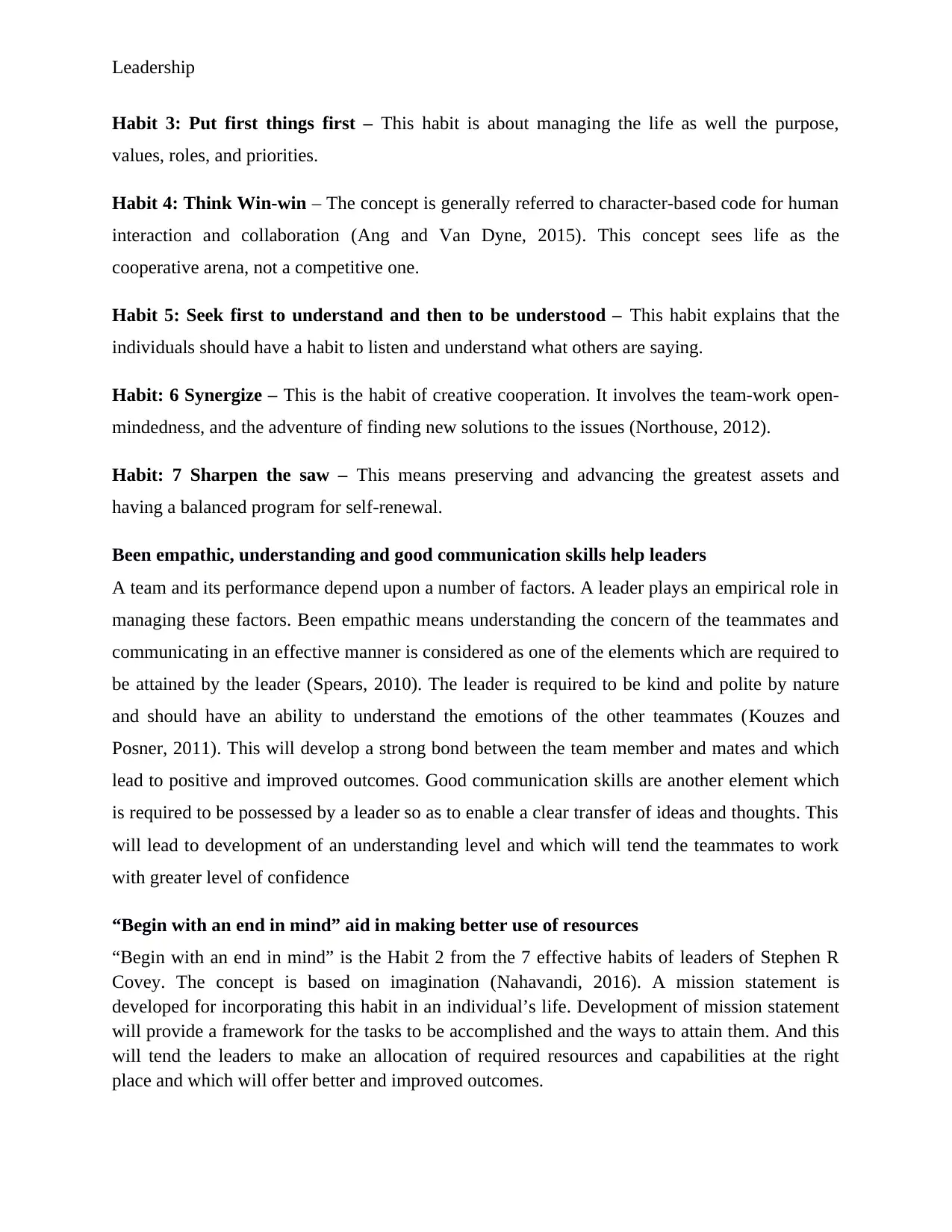
Leadership
Habit 3: Put first things first – This habit is about managing the life as well the purpose,
values, roles, and priorities.
Habit 4: Think Win-win – The concept is generally referred to character-based code for human
interaction and collaboration (Ang and Van Dyne, 2015). This concept sees life as the
cooperative arena, not a competitive one.
Habit 5: Seek first to understand and then to be understood – This habit explains that the
individuals should have a habit to listen and understand what others are saying.
Habit: 6 Synergize – This is the habit of creative cooperation. It involves the team-work open-
mindedness, and the adventure of finding new solutions to the issues (Northouse, 2012).
Habit: 7 Sharpen the saw – This means preserving and advancing the greatest assets and
having a balanced program for self-renewal.
Been empathic, understanding and good communication skills help leaders
A team and its performance depend upon a number of factors. A leader plays an empirical role in
managing these factors. Been empathic means understanding the concern of the teammates and
communicating in an effective manner is considered as one of the elements which are required to
be attained by the leader (Spears, 2010). The leader is required to be kind and polite by nature
and should have an ability to understand the emotions of the other teammates (Kouzes and
Posner, 2011). This will develop a strong bond between the team member and mates and which
lead to positive and improved outcomes. Good communication skills are another element which
is required to be possessed by a leader so as to enable a clear transfer of ideas and thoughts. This
will lead to development of an understanding level and which will tend the teammates to work
with greater level of confidence
“Begin with an end in mind” aid in making better use of resources
“Begin with an end in mind” is the Habit 2 from the 7 effective habits of leaders of Stephen R
Covey. The concept is based on imagination (Nahavandi, 2016). A mission statement is
developed for incorporating this habit in an individual’s life. Development of mission statement
will provide a framework for the tasks to be accomplished and the ways to attain them. And this
will tend the leaders to make an allocation of required resources and capabilities at the right
place and which will offer better and improved outcomes.
Habit 3: Put first things first – This habit is about managing the life as well the purpose,
values, roles, and priorities.
Habit 4: Think Win-win – The concept is generally referred to character-based code for human
interaction and collaboration (Ang and Van Dyne, 2015). This concept sees life as the
cooperative arena, not a competitive one.
Habit 5: Seek first to understand and then to be understood – This habit explains that the
individuals should have a habit to listen and understand what others are saying.
Habit: 6 Synergize – This is the habit of creative cooperation. It involves the team-work open-
mindedness, and the adventure of finding new solutions to the issues (Northouse, 2012).
Habit: 7 Sharpen the saw – This means preserving and advancing the greatest assets and
having a balanced program for self-renewal.
Been empathic, understanding and good communication skills help leaders
A team and its performance depend upon a number of factors. A leader plays an empirical role in
managing these factors. Been empathic means understanding the concern of the teammates and
communicating in an effective manner is considered as one of the elements which are required to
be attained by the leader (Spears, 2010). The leader is required to be kind and polite by nature
and should have an ability to understand the emotions of the other teammates (Kouzes and
Posner, 2011). This will develop a strong bond between the team member and mates and which
lead to positive and improved outcomes. Good communication skills are another element which
is required to be possessed by a leader so as to enable a clear transfer of ideas and thoughts. This
will lead to development of an understanding level and which will tend the teammates to work
with greater level of confidence
“Begin with an end in mind” aid in making better use of resources
“Begin with an end in mind” is the Habit 2 from the 7 effective habits of leaders of Stephen R
Covey. The concept is based on imagination (Nahavandi, 2016). A mission statement is
developed for incorporating this habit in an individual’s life. Development of mission statement
will provide a framework for the tasks to be accomplished and the ways to attain them. And this
will tend the leaders to make an allocation of required resources and capabilities at the right
place and which will offer better and improved outcomes.
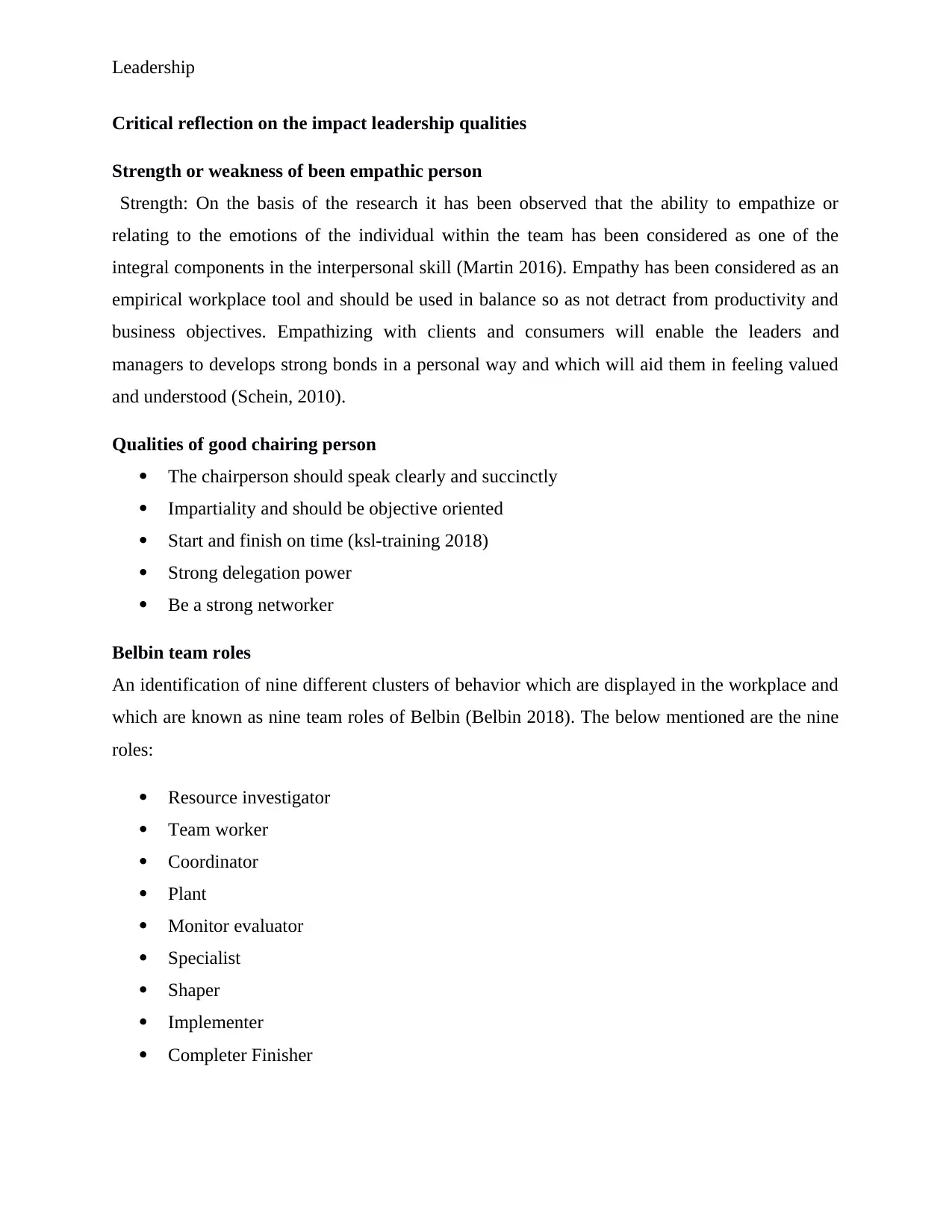
Leadership
Critical reflection on the impact leadership qualities
Strength or weakness of been empathic person
Strength: On the basis of the research it has been observed that the ability to empathize or
relating to the emotions of the individual within the team has been considered as one of the
integral components in the interpersonal skill (Martin 2016). Empathy has been considered as an
empirical workplace tool and should be used in balance so as not detract from productivity and
business objectives. Empathizing with clients and consumers will enable the leaders and
managers to develops strong bonds in a personal way and which will aid them in feeling valued
and understood (Schein, 2010).
Qualities of good chairing person
The chairperson should speak clearly and succinctly
Impartiality and should be objective oriented
Start and finish on time (ksl-training 2018)
Strong delegation power
Be a strong networker
Belbin team roles
An identification of nine different clusters of behavior which are displayed in the workplace and
which are known as nine team roles of Belbin (Belbin 2018). The below mentioned are the nine
roles:
Resource investigator
Team worker
Coordinator
Plant
Monitor evaluator
Specialist
Shaper
Implementer
Completer Finisher
Critical reflection on the impact leadership qualities
Strength or weakness of been empathic person
Strength: On the basis of the research it has been observed that the ability to empathize or
relating to the emotions of the individual within the team has been considered as one of the
integral components in the interpersonal skill (Martin 2016). Empathy has been considered as an
empirical workplace tool and should be used in balance so as not detract from productivity and
business objectives. Empathizing with clients and consumers will enable the leaders and
managers to develops strong bonds in a personal way and which will aid them in feeling valued
and understood (Schein, 2010).
Qualities of good chairing person
The chairperson should speak clearly and succinctly
Impartiality and should be objective oriented
Start and finish on time (ksl-training 2018)
Strong delegation power
Be a strong networker
Belbin team roles
An identification of nine different clusters of behavior which are displayed in the workplace and
which are known as nine team roles of Belbin (Belbin 2018). The below mentioned are the nine
roles:
Resource investigator
Team worker
Coordinator
Plant
Monitor evaluator
Specialist
Shaper
Implementer
Completer Finisher
⊘ This is a preview!⊘
Do you want full access?
Subscribe today to unlock all pages.

Trusted by 1+ million students worldwide
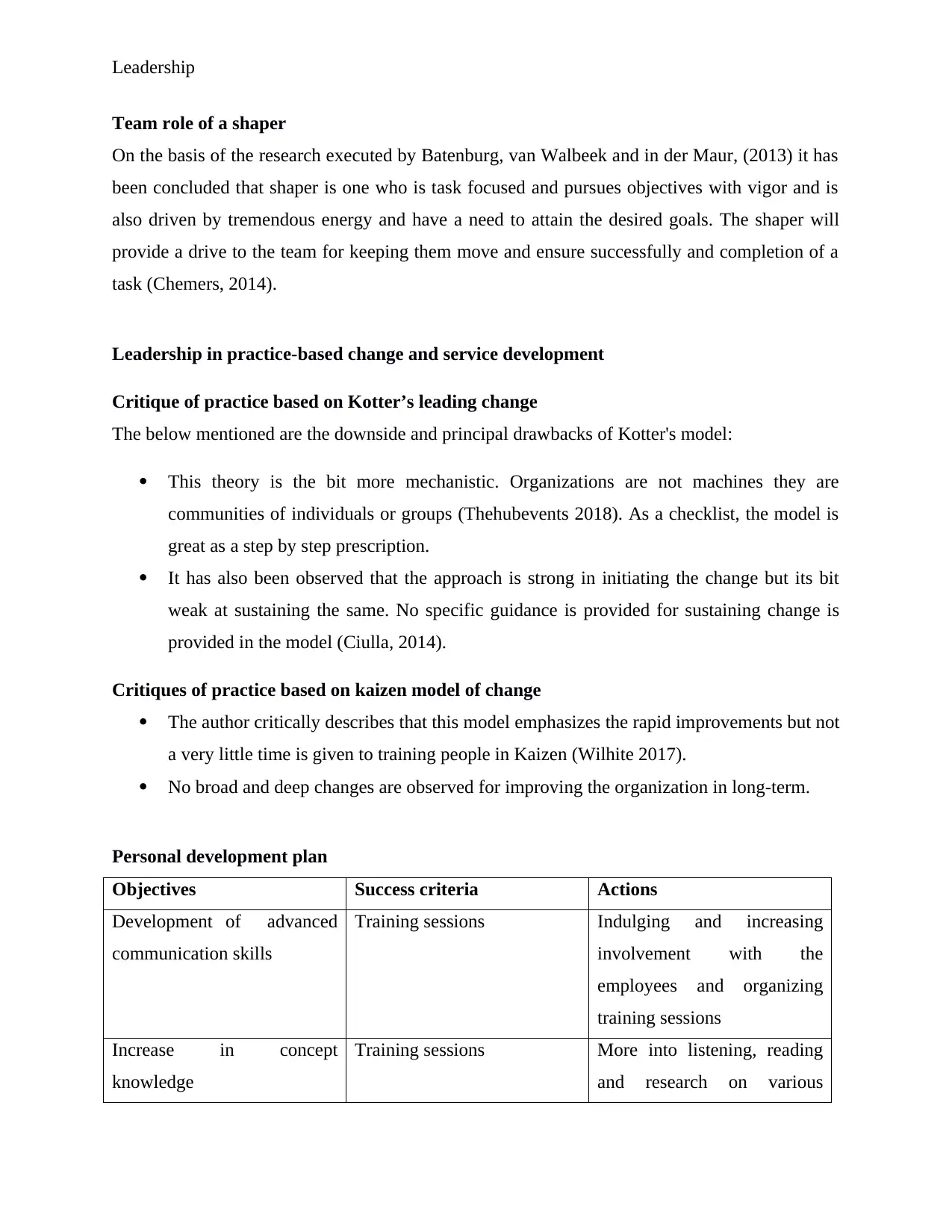
Leadership
Team role of a shaper
On the basis of the research executed by Batenburg, van Walbeek and in der Maur, (2013) it has
been concluded that shaper is one who is task focused and pursues objectives with vigor and is
also driven by tremendous energy and have a need to attain the desired goals. The shaper will
provide a drive to the team for keeping them move and ensure successfully and completion of a
task (Chemers, 2014).
Leadership in practice-based change and service development
Critique of practice based on Kotter’s leading change
The below mentioned are the downside and principal drawbacks of Kotter's model:
This theory is the bit more mechanistic. Organizations are not machines they are
communities of individuals or groups (Thehubevents 2018). As a checklist, the model is
great as a step by step prescription.
It has also been observed that the approach is strong in initiating the change but its bit
weak at sustaining the same. No specific guidance is provided for sustaining change is
provided in the model (Ciulla, 2014).
Critiques of practice based on kaizen model of change
The author critically describes that this model emphasizes the rapid improvements but not
a very little time is given to training people in Kaizen (Wilhite 2017).
No broad and deep changes are observed for improving the organization in long-term.
Personal development plan
Objectives Success criteria Actions
Development of advanced
communication skills
Training sessions Indulging and increasing
involvement with the
employees and organizing
training sessions
Increase in concept
knowledge
Training sessions More into listening, reading
and research on various
Team role of a shaper
On the basis of the research executed by Batenburg, van Walbeek and in der Maur, (2013) it has
been concluded that shaper is one who is task focused and pursues objectives with vigor and is
also driven by tremendous energy and have a need to attain the desired goals. The shaper will
provide a drive to the team for keeping them move and ensure successfully and completion of a
task (Chemers, 2014).
Leadership in practice-based change and service development
Critique of practice based on Kotter’s leading change
The below mentioned are the downside and principal drawbacks of Kotter's model:
This theory is the bit more mechanistic. Organizations are not machines they are
communities of individuals or groups (Thehubevents 2018). As a checklist, the model is
great as a step by step prescription.
It has also been observed that the approach is strong in initiating the change but its bit
weak at sustaining the same. No specific guidance is provided for sustaining change is
provided in the model (Ciulla, 2014).
Critiques of practice based on kaizen model of change
The author critically describes that this model emphasizes the rapid improvements but not
a very little time is given to training people in Kaizen (Wilhite 2017).
No broad and deep changes are observed for improving the organization in long-term.
Personal development plan
Objectives Success criteria Actions
Development of advanced
communication skills
Training sessions Indulging and increasing
involvement with the
employees and organizing
training sessions
Increase in concept
knowledge
Training sessions More into listening, reading
and research on various
Paraphrase This Document
Need a fresh take? Get an instant paraphrase of this document with our AI Paraphraser
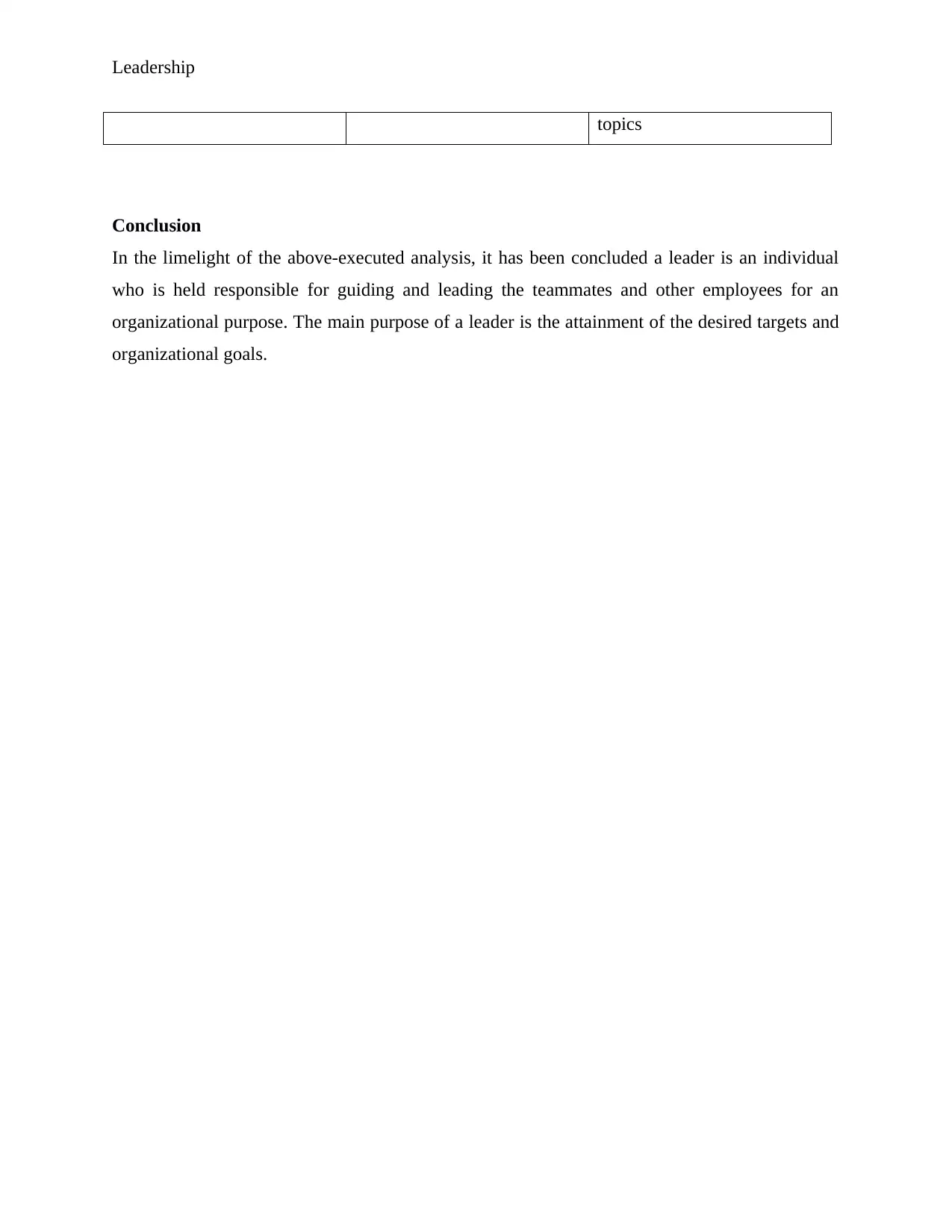
Leadership
topics
Conclusion
In the limelight of the above-executed analysis, it has been concluded a leader is an individual
who is held responsible for guiding and leading the teammates and other employees for an
organizational purpose. The main purpose of a leader is the attainment of the desired targets and
organizational goals.
topics
Conclusion
In the limelight of the above-executed analysis, it has been concluded a leader is an individual
who is held responsible for guiding and leading the teammates and other employees for an
organizational purpose. The main purpose of a leader is the attainment of the desired targets and
organizational goals.

Leadership
References
Batenburg, R., van Walbeek, W. and in der Maur, W., 2013. Belbin role diversity and team
performance: is there a relationship?. Journal of Management Development, 32(8), pp.901-913.
Belbin, 2018, The nine Belbin team roles, Assessed on 6th January 2018, .
Chemers, M., 2014. An integrative theory of leadership. Psychology Press.
Chhokar, J.S., Brodbeck, F.C. and House, R.J. eds., 2013. Culture and leadership across the
world: The GLOBE book of in-depth studies of 25 societies. Routledge.
Ciulla, J.B. ed., 2014. Ethics, the heart of leadership. ABC-CLIO.
Goleman, D., Boyatzis, R.E. and McKee, A., 2013. Primal leadership: Unleashing the power of
emotional intelligence. Harvard Business Press.
Hackman, M.Z. and Johnson, C.E., 2013. Leadership: A communication perspective. Waveland
Press.
Hemlin, S., Allwood, C.M., Martin, B. and Mumford, M.D. eds., 2014. Creativity and leadership
in science, technology, and innovation. Routledge.
Jackson, B. and Parry, K., 2011. A very short fairly interesting and reasonably cheap book about
studying leadership. Sage.
Komives, S.R. and Wagner, W.E., 2016. Leadership for a better world: Understanding the
social change model of leadership development. John Wiley & Sons.
Kouzes, J.M. and Posner, B.Z., 2011. Credibility: How leaders gain and lose it, why people
demand it (Vol. 244). John Wiley & Sons.
ksl-training, 2018, Tips for chairing meeting, Assessed on 6th January 2018,
Managementstudyguide, 2018, Importance of leadership, Assessed on 6th January 2018, .
Martin, J, 2016, Can empathy be a strength in the workplace, Assessed on 6th December 2018, .
References
Batenburg, R., van Walbeek, W. and in der Maur, W., 2013. Belbin role diversity and team
performance: is there a relationship?. Journal of Management Development, 32(8), pp.901-913.
Belbin, 2018, The nine Belbin team roles, Assessed on 6th January 2018, .
Chemers, M., 2014. An integrative theory of leadership. Psychology Press.
Chhokar, J.S., Brodbeck, F.C. and House, R.J. eds., 2013. Culture and leadership across the
world: The GLOBE book of in-depth studies of 25 societies. Routledge.
Ciulla, J.B. ed., 2014. Ethics, the heart of leadership. ABC-CLIO.
Goleman, D., Boyatzis, R.E. and McKee, A., 2013. Primal leadership: Unleashing the power of
emotional intelligence. Harvard Business Press.
Hackman, M.Z. and Johnson, C.E., 2013. Leadership: A communication perspective. Waveland
Press.
Hemlin, S., Allwood, C.M., Martin, B. and Mumford, M.D. eds., 2014. Creativity and leadership
in science, technology, and innovation. Routledge.
Jackson, B. and Parry, K., 2011. A very short fairly interesting and reasonably cheap book about
studying leadership. Sage.
Komives, S.R. and Wagner, W.E., 2016. Leadership for a better world: Understanding the
social change model of leadership development. John Wiley & Sons.
Kouzes, J.M. and Posner, B.Z., 2011. Credibility: How leaders gain and lose it, why people
demand it (Vol. 244). John Wiley & Sons.
ksl-training, 2018, Tips for chairing meeting, Assessed on 6th January 2018,
Managementstudyguide, 2018, Importance of leadership, Assessed on 6th January 2018, .
Martin, J, 2016, Can empathy be a strength in the workplace, Assessed on 6th December 2018, .
⊘ This is a preview!⊘
Do you want full access?
Subscribe today to unlock all pages.

Trusted by 1+ million students worldwide
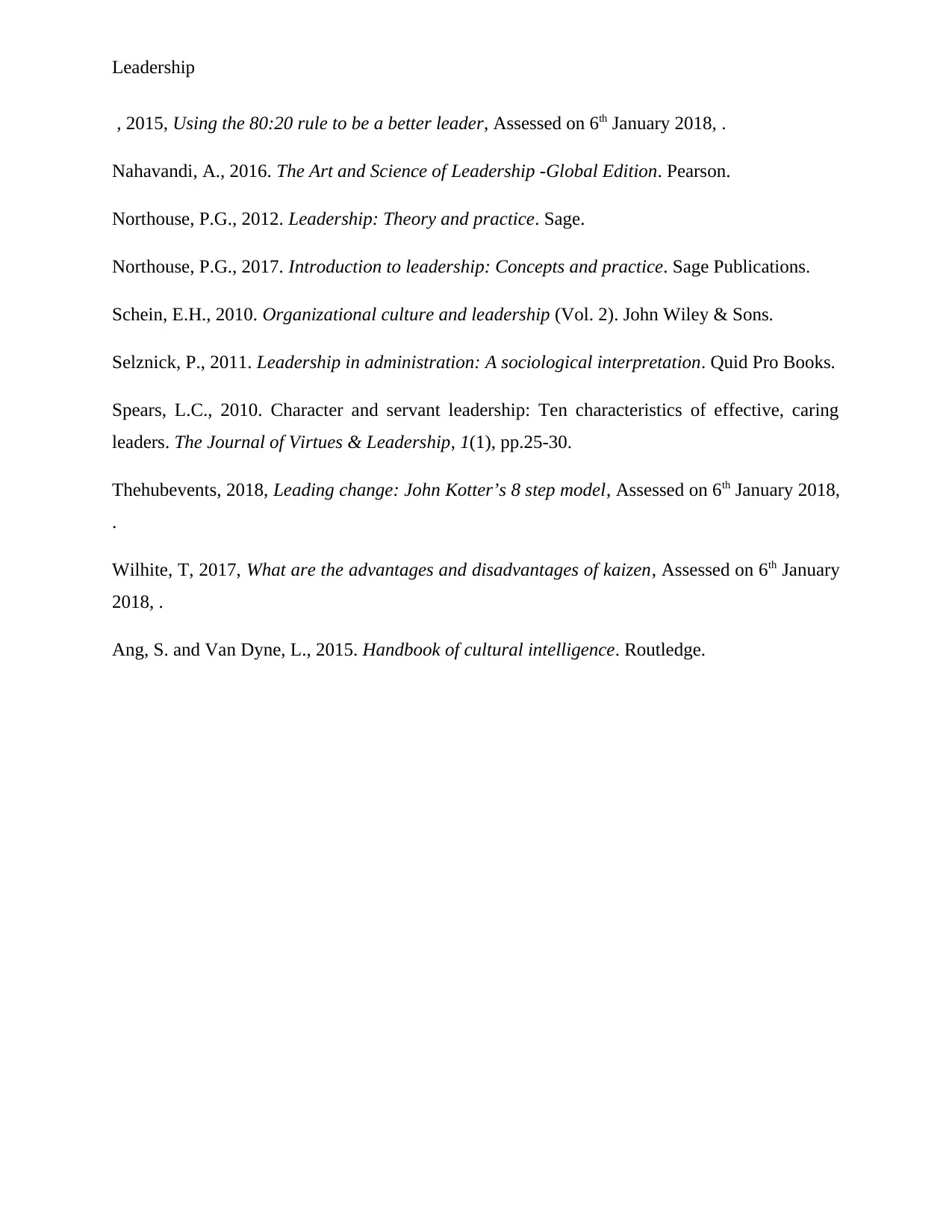
Leadership
, 2015, Using the 80:20 rule to be a better leader, Assessed on 6th January 2018, .
Nahavandi, A., 2016. The Art and Science of Leadership -Global Edition. Pearson.
Northouse, P.G., 2012. Leadership: Theory and practice. Sage.
Northouse, P.G., 2017. Introduction to leadership: Concepts and practice. Sage Publications.
Schein, E.H., 2010. Organizational culture and leadership (Vol. 2). John Wiley & Sons.
Selznick, P., 2011. Leadership in administration: A sociological interpretation. Quid Pro Books.
Spears, L.C., 2010. Character and servant leadership: Ten characteristics of effective, caring
leaders. The Journal of Virtues & Leadership, 1(1), pp.25-30.
Thehubevents, 2018, Leading change: John Kotter’s 8 step model, Assessed on 6th January 2018,
.
Wilhite, T, 2017, What are the advantages and disadvantages of kaizen, Assessed on 6th January
2018, .
Ang, S. and Van Dyne, L., 2015. Handbook of cultural intelligence. Routledge.
, 2015, Using the 80:20 rule to be a better leader, Assessed on 6th January 2018, .
Nahavandi, A., 2016. The Art and Science of Leadership -Global Edition. Pearson.
Northouse, P.G., 2012. Leadership: Theory and practice. Sage.
Northouse, P.G., 2017. Introduction to leadership: Concepts and practice. Sage Publications.
Schein, E.H., 2010. Organizational culture and leadership (Vol. 2). John Wiley & Sons.
Selznick, P., 2011. Leadership in administration: A sociological interpretation. Quid Pro Books.
Spears, L.C., 2010. Character and servant leadership: Ten characteristics of effective, caring
leaders. The Journal of Virtues & Leadership, 1(1), pp.25-30.
Thehubevents, 2018, Leading change: John Kotter’s 8 step model, Assessed on 6th January 2018,
.
Wilhite, T, 2017, What are the advantages and disadvantages of kaizen, Assessed on 6th January
2018, .
Ang, S. and Van Dyne, L., 2015. Handbook of cultural intelligence. Routledge.
1 out of 10
Related Documents
Your All-in-One AI-Powered Toolkit for Academic Success.
+13062052269
info@desklib.com
Available 24*7 on WhatsApp / Email
![[object Object]](/_next/static/media/star-bottom.7253800d.svg)
Unlock your academic potential
Copyright © 2020–2025 A2Z Services. All Rights Reserved. Developed and managed by ZUCOL.





